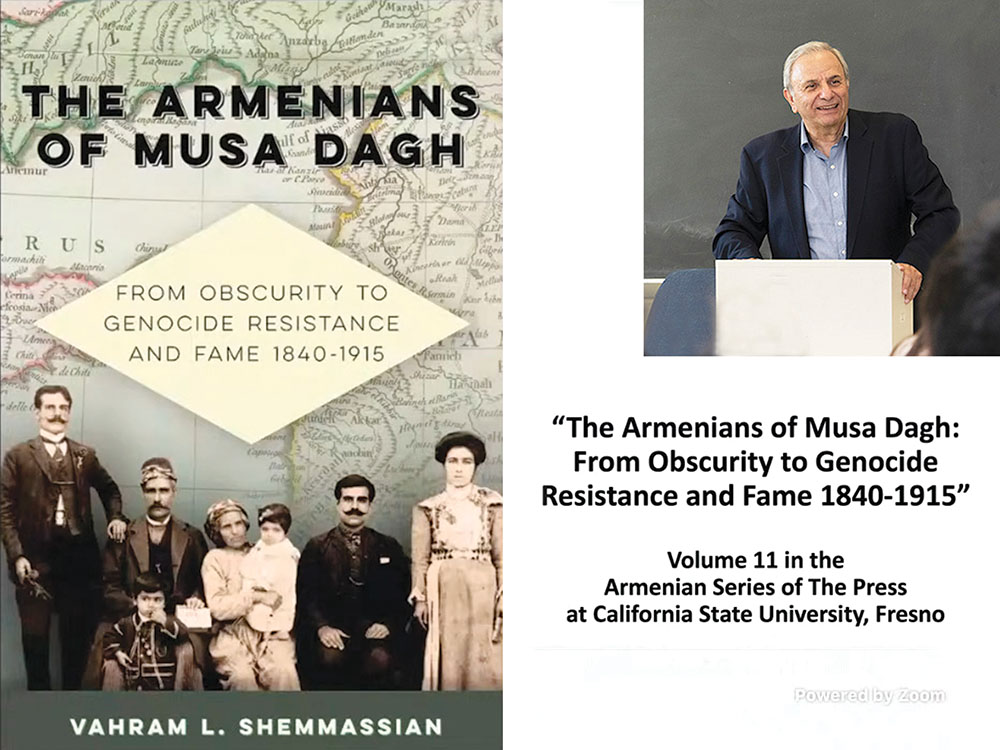
Christine Pambukyan
Staff Writer
“I did not have an agenda… I did not want to prove anything. I just wanted to bring all the sources from all angles, from all perspectives, from all kinds of organizations and institutions in order for me to draw a picture of Musa Dagh,” said Dr. Vahram Shemmassian, director of the Armenians Studies Program at the California State University of Northridge, while discussing his newest publication, The Armenians of Musa Dagh: From Obscurity to Genocide Resistance and Fame 1840 – 1915.
Within his new book, Dr. Shemmassian, a descendant of the people of Musa Dagh, presents a comprehensive history of Armenians of Musa Dagh and how the Armenians rose to prominence with their resistance during the Genocide of 1915. Through seven chapters and an epilogue containing maps, tables, and many rare photographs of the people who called Musa Dagh their home, Dr. Shemmassian analyzes the social, economic, political, and educational history of the region made up of six Armenian villages.
On Saturday, February 6, 2021, Dr. Shemmassian discussed his new book, The Armenians of Musa Dagh, through a virtual presentation on Zoom. In his discussion, Dr. Shemmassian described his experiences writing the book, what he learned, and the contents within the five hundred and fifty-five pages. The Armenians of Musa Dagh was published as volume 11 in the Armenian Series of The Press at California State University, Fresno.
Dr. Shemmassian began with an overview of his connections to Musa Dagh and his research. Because he was born and raised in Lebanon, he only knew about Musa Dagh through memorials and celebrations of Armenian holidays. He was also exposed to the dialects of Musa Dagh through conversations between the adults in his family. When he began writing his master’s thesis about the connection between the homeland and the Armenians in Lebanon and Syria, he also began to collect information about Musa Dagh. He wrote information he learned on paper, wrappers, and anything he could get his hands on as he asked the surprised survivors about Musa Dagh. One unfortunate day during the Lebanese war, his home was bombed resulting in the death of his mother. After this, he was even more interested in writing about Musa Dagh and continued his research.
After describing his journey of extensive research about Musa Dagh, Dr. Shemmassian gave an overview of each chapter in his book. The first chapter of the publication gives a general background of Musa Dagh. It includes the origins of the name “Musa Dagh,” the names and origins of the villages, statistics about the population and weather of the regions, geographical descriptions, and information about the neighbors of the region.
The second chapter discusses the socioeconomic conditions of Musa Dagh; particularly the progression and change that came after British diplomat John Baker introduced new fruits, vegetables, and sericulture (silkworm culture) to the Armenians of Musa Dagh upon retiring in the region. It also discusses animal husbandry and comb making in Yoronolok, the region Dr. Shemmassian’s father is from; immigration to the United States; and heavy taxation the Armenians had to endure with the region.
The third chapter discusses the Armenian Apostolic Church. It also mentions the Protestant missionary inroads to Musa Dagh in June of 1840 and the Catholics in 1891; and how they gave rise to disputes between the three denominations, confessional disagreements, and education in the region. Then, the fourth chapter discusses the strides made in education by the Apostolic, Catholic, and Protestant Armenians of Musa Dagh. Since all of the schools in the region were elementary schools, graduates left for higher education to Europe, central Turkey, and Lebanon.
The fifth chapter describes the revolutionary movement in Musa Dagh through the records of the French, Austria-Hungarians, Antioch representatives the A.R.F. Federation, and the Hnchak Party. The sixth chapter describes the massacres of Musa Dagh that occurred around the time of the Adana Massacres in the late 19th century. They were able to resist, but those working for the Ottoman Turkish landlords were massacred. The chapter also mentions the relief movement by Europe, missionaries, the Armenian General Benevolent Union, the Armenian prelate of Aleppo, and the Armenian Patriarchate of Istanbul; as well as the employment project of widows and orphans of massacre victims to avoid prostitution by the Turkish and Kurdish members of the Ottoman Empire.
The concluding chapter of the book discusses the resistance of the Armenians against the Ottoman Turks from a historical perspective, including the widespread press coverage the event received.
Finally, the epilogue notes and describes the forgotten history of the two thousand Musa Dagh Armenians that elected to be deported to Hama, Syria because they did not believe that resistance would be successful. One thousand of them perished due to famine, disease, and exposure.
Dr. Shemmassian concluded his discussion by emphasizing the importance of being impartial and honest while writing history. He asserted that we must step away from the romanticization of history because it can be detrimental to the purpose of history: to tell and documents the events of the past for future generations.
At the end of the discussion, viewers were able to ask Dr. Shemmassian and Professor Barlow Der Mugrdechian questions about the book through the chat function on Zoom. A recording of the discussion, along with other lectures of this semester can be found on the Armenian Studies YouTube Channel at http://bit.ly/armenianstudies.
Also, The Armenians of Musa Dagh is available for purchase through Abril Bookstore at https://www.abrilbooks.com, The National Association for Armenian Studies and Research Bookstore at https://naasr.org/pages/bookstore, and the Armenian Missionary Association of America Bookstore at https://amaa.org/bookstore/.
 Hye Sharzhoom Armenian Action
Hye Sharzhoom Armenian Action